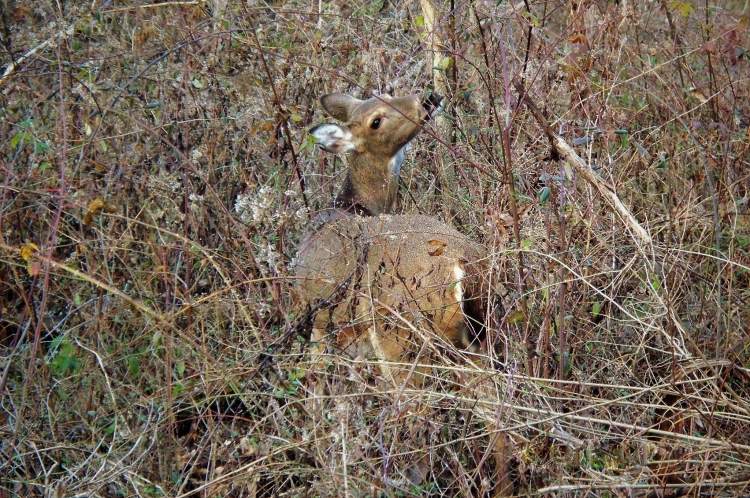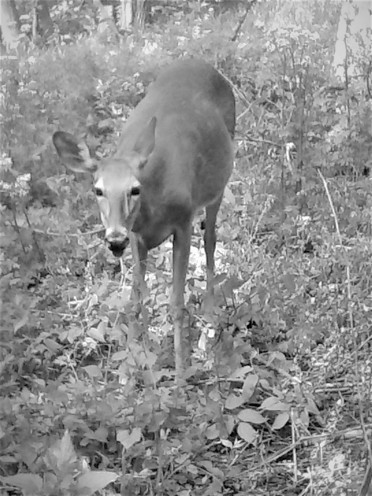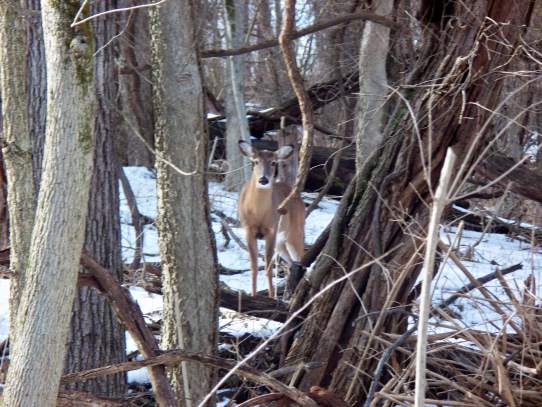These big eared herbivores are now a fixture of our urban landscape – but how well do we really know them?

Most gardeners know that deer love Hostas (they enjoy eating many other members of the lily family too). But why do deer seem so comfortable with city life? Wouldn’t they be happier out in the country somewhere? This little quiz won’t provide the answer to that, but after taking it you may have a better understanding of why urban deer are thriving.
(The questions below refer to the Whitetail deer, Odoc0ileus virginianus only. All pictures taken at Beargrass Creek SNP.)
TRUE or FALSE?
1. If starving, deer will eat any plant to survive.
2. Does usually have twins.
3. Bucks are easy to tell from does, since they look and behave differently.
4. Deer are naturally affectionate with members of their family.
5. It is rare for deer to starve to death.
6. A deer with a broken leg is not likely to survive.
7. Deer society is matriarchal.
8. The main causes of deer mortality are vehicle collisions and coyotes.
9. Does can get pregnant when they are yearlings.
10. With high deer numbers forests cannot regenerate, wildflowers disappear, and invasive plants increase.
11. It can be hard to see deer even when they are just a few yards away.
ANSWERS

- Big Mama enjoying some Japanese honeysuckle
1. False. When deer have plenty to eat, they show definite preferences for some plants over others. When starving they will eat almost any plant to survive – over 650 plant species are on the menu. Though they relish plants we can’t imagine eating, like Poison ivy, they will not browse the truly poisonous White snakeroot and Poison hemlock. The deer winter diet in our forest consists of the invasive viney groundcover Wintercreeper, Euonymus fortunei. All Euonymus are highly preferred by deer.

- Big Mama with babies on board
2. True. Twins are the norm for healthy mature does in good habitat. This helps to explain how deer populations can increase so quickly. It’s a good survival adaptation in climates where harsh winters may kill many deer. Very young or nutritionally deprived does are likely to have singles, and these fawns have lower survival odds.

3. False. Mature bucks look different when they have antlers, and behave different during the rut when they are pumped up with testosterone. After the rut they are mousy, shy animals that can be bullied by a dominant doe. Their foreheads are always flatter, but young bucks in particular may not look very muscular. Behavior is a better clue – bucks tend to stay out of sight more, and at most seasons keep the company of other bucks.

- Young siblings enjoying some mutual grooming
4. True. My own observations bear this out too. Family members hang out in a tight group, and will groom each other. Young siblings love to play tag. Mom is more reserved, always vigilant in the background. When fawning time comes, she will chase off her young offspring from the previous year. Her daughters will return to the group later in summer.

False. Starvation is not uncommon during harsh winters in the north. Sadly, when deer populations surge, tens of thousands may die if snow cover is deeper and lasts longer than usual. This happens periodically in Michigan’s UP. Fawns take the brunt of it – their smaller bodies store less fat, and deep snow can make it even harder for them to move about or reach browse.
6. False. I don’t have a picture of a deer with an injured leg, but have encountered a few such animals in our forest. And they seem to do surprisingly well. One doe with a dangling right front leg lurches forward like she’s headed for a fall with every step, but she’s been this way for over a year and raised a fawn to boot! In wolf country it’s a different story I’m sure. But with many cars and few predators in most places, three legged deer are fairly common.

7. True. The matriarch in the photo above I have named “Big Mama”, not for her size, but because she is a strong wise female. As a dominant doe she holds a choice area, and her daughters get the ones adjoining hers. She has twins every year, and leads a group that includes some daughters from previous years. She watches for danger, decides where they go and when, and passes her knowledge on to the younger ones.
In contrast, bucks are assertive for just a couple months a year during the rut. The rest of the time they may wander widely and hang out with other bucks.

8. False. Hunting accounts for the most deer mortality by far. Depending on the location, starvation or car collisions amount to a distant second, and predation by coyotes and wolves takes even less. Deer in urban areas only have the cars to deal with. The picture is different for young fawns -their highest mortality results from coyote predation.

9. True. This young doe could could breed (usually later) in her first winter and give birth to twins! This only happens in places where the deer are very well nourished, such as on agricultural crops. Very young breeders mostly have only one fawn, and it will be more at risk due to the inexperience of its teenage mom.

10. True. For a number of reasons, deer populations are at a historically high level, and there is ongoing research on their impacts in many places (such as the pellet count study here at Beargrass Creek SNP.) It’s likely that our forest is suffering from all of these deer population impacts.

11. Very True – as this picture of two young deer proves!
Diane Murphy
Rosemary, I’m enjoying your blogs, and especially this one about the white tailed deer in the forest,
of course. I saw quite a few in a group there last week, many of which were bucks hanging out together.
Keep up the good work. Hope to see you there soon.
LikeLike
oneforestfragment
Thanks Diane! I haven’t been seeing any deer for about 8 days – they seem to have moved. Maybe done with the wintercreeper and going for new food sources?
LikeLike